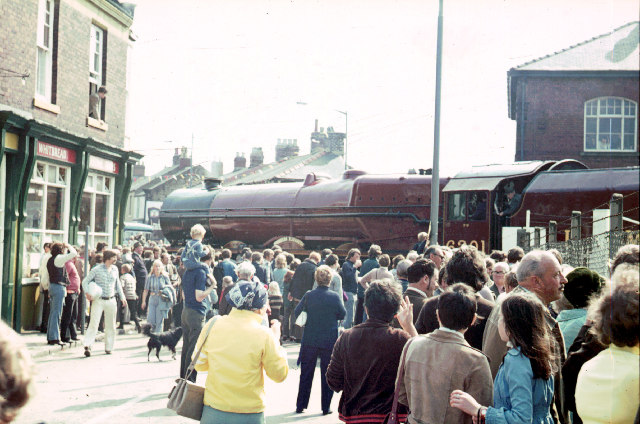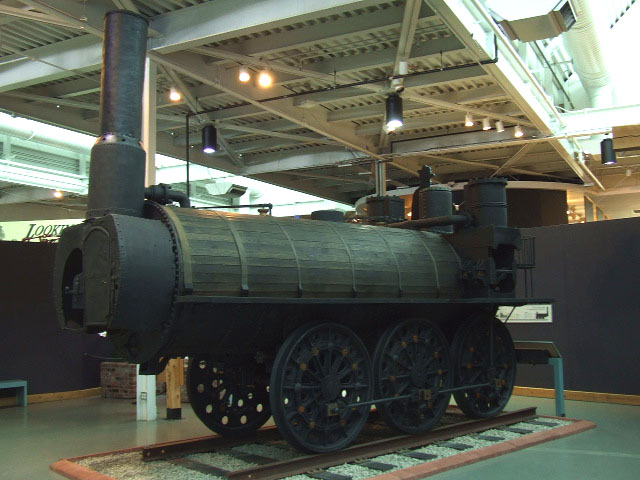|
Hackworth Park
Hackworth Park (alternately the Recreation Ground) is a park in Shildon, County Durham, England. It was named after Timothy Hackworth, a railway pioneer from the town. History The park was opened on Saturday 28 September 1912. To celebrate the opening there was a procession which included horses, cyclists, the fire brigade, miners lodges and two brass bands. On 30 August 1913 the bandstand was opened. There are two drinking fountains in the park; the first was given by the committee of the old Shildon Working Men's Club and has an ornate canopy with a centre column and herons surrounding the drinking tube. The second is octagonal, it has 8 roundels between dragon's heads depicting a railway locomotive designed by Timothy Hackworth and is Grade II listed with Historic England. The park was named after Timothy Hackworth, a railway pioneer who came from Shildon, there is a statue of him in the park, the original statue was vandalised and moved to the nearby National Railway Museum S ... [...More Info...] [...Related Items...] OR: [Wikipedia] [Google] [Baidu] |
Shildon
Shildon is a town and civil parish in County Durham (district), County Durham, in England. The population taken at the 2011 Census was 9,976. The town has the Locomotion Museum, due to it having the first , built in 1825, and locomotive works on the Stockton and Darlington Railway. History The name Shildon comes from the Old English word ''sceld'', This translates as 'shelf shaped hill' or 'shield/refuge'. Another possibility is the Old English word ''syclfe'' meaning 'shelf' and the suffix ''duri'' meaning 'hill'. This refers to the town's location on a limestone escarpment.Shildon County Durham Conservation Area Prepared for Sedgefield Borough Council Conservation Area Character Appraisal December 2008 ''Report No: 0055/1-08'' Report by Archaeo-Environment Ltd The earliest inhabitants of the area were most likely present from the Mesolithic period some 6,000 years ago. Although no evidence of settlement has been found in Shildon itself a small Stone tool, flint tool dis ... [...More Info...] [...Related Items...] OR: [Wikipedia] [Google] [Baidu] |
Park
A park is an area of natural, semi-natural or planted space set aside for human enjoyment and recreation or for the protection of wildlife or natural habitats. Urban parks are urban green space, green spaces set aside for recreation inside towns and cities. National parks and country parks are green spaces used for recreation in the countryside. State parks and provincial parks are administered by sub-national government states and agencies. Parks may consist of grassy areas, rocks, soil and trees, but may also contain buildings and other artifacts such as monuments, fountains or playground structures. Many parks have fields for playing sports such as baseball and football, and paved areas for games such as basketball. Many parks have trails for walking, biking and other activities. Some parks are built adjacent to bodies of water or watercourses and may comprise a beach or boat dock area. Urban parks often have benches for sitting and may contain picnic tables and barbecue gr ... [...More Info...] [...Related Items...] OR: [Wikipedia] [Google] [Baidu] |
Timothy Hackworth
Timothy Hackworth (22 December 1786 – 7 July 1850) was an English steam locomotive engineer who lived in Shildon, County Durham, England and was the first locomotive superintendent of the Stockton and Darlington Railway. Youth and early work Timothy Hackworth was born in Wylam in 1786, five years after his fellow railway pioneer George Stephenson had been born in the same village. Hackworth was the eldest son of John Hackworth who occupied the position of foreman blacksmith at Wylam Colliery until his death in 1804; the father had already acquired a considerable reputation as a mechanical worker and boiler maker. At the end of his apprenticeship in 1810 Timothy took over his father's position. Since 1804, the mine owner, Christopher Blackett had been investigating the possibilities of working the mine's short colliery tramroad by steam traction. Blackett set up a four-man working group including himself, William Hedley, the viewer; Timothy Hackworth, the new foreman smith an ... [...More Info...] [...Related Items...] OR: [Wikipedia] [Google] [Baidu] |
Heron
The herons are long-legged, long-necked, freshwater and coastal birds in the family Ardeidae, with 72 recognised species, some of which are referred to as egrets or bitterns rather than herons. Members of the genera ''Botaurus'' and ''Ixobrychus'' are referred to as bitterns, and, together with the zigzag heron, or zigzag bittern, in the monotypic genus ''Zebrilus'', form a monophyletic group within the Ardeidae. Egrets do not form a biologically distinct group from herons, and tend to be named differently because they are mainly white or have decorative plumes in breeding plumage. Herons, by evolutionary adaptation, have long beaks. The classification of the individual heron/egret species is fraught with difficulty, and no clear consensus exists about the correct placement of many species into either of the two major genera, '' Ardea'' and ''Egretta''. Similarly, the relationships of the genera in the family are not completely resolved. However, one species formerly considered ... [...More Info...] [...Related Items...] OR: [Wikipedia] [Google] [Baidu] |
Historic England
Historic England (officially the Historic Buildings and Monuments Commission for England) is an executive non-departmental public body of the British Government sponsored by the Department for Digital, Culture, Media and Sport. It is tasked with protecting the historic environment of England by preserving and listing historic buildings, scheduling ancient monuments, registering historic Parks and Gardens and by advising central and local government. The body was officially created by the National Heritage Act 1983, and operated from April 1984 to April 2015 under the name of English Heritage. In 2015, following the changes to English Heritage's structure that moved the protection of the National Heritage Collection into the voluntary sector in the English Heritage Trust, the body that remained was rebranded as Historic England. The body also inherited the Historic England Archive from the old English Heritage, and projects linked to the archive such as Britain from Above, w ... [...More Info...] [...Related Items...] OR: [Wikipedia] [Google] [Baidu] |
National Railway Museum Shildon
Locomotion, previously known as Locomotion the National Railway Museum at Shildon, is a railway museum in Shildon, County Durham, England. The museum was renamed in 2017 when it became part of the Science Museum Group. Overview The museum was opened on 22 October 2004 by Prime Minister and local MP Tony Blair. Built at a cost of £11.3 million, it is based on the former "Timothy Hackworth Victorian Railway Museum". The museum is operated in partnership with Durham County Council and was expected to bring 60,000 visitors a year to the small town. However, during its first six months, the museum attracted 94,000 visits. Locomotion was shortlisted as one of the final five contenders in the Gulbenkian Prize, which is the largest arts prize in the United Kingdom. As part of the 2025 plans for the National Railway Museum, a second building will be built to house more of the wider collection. In addition, parts of the original museum including the coal drops will be restored having f ... [...More Info...] [...Related Items...] OR: [Wikipedia] [Google] [Baidu] |
Colliery
Coal mining is the process of extracting coal from the ground. Coal is valued for its energy content and since the 1880s has been widely used to generate electricity. Steel and cement industries use coal as a fuel for extraction of iron from iron ore and for cement production. In the United Kingdom and South Africa, a coal mine and its structures are a colliery, a coal mine is called a 'pit', and the above-ground structures are a 'pit head'. In Australia, "colliery" generally refers to an underground coal mine. Coal mining has had many developments in recent years, from the early days of men tunneling, digging and manually extracting the coal on carts to large open-cut and longwall mines. Mining at this scale requires the use of draglines, trucks, conveyors, hydraulic jacks and shearers. The coal mining industry has a long history of significant negative environmental impacts on local ecosystems, health impacts on local communities and workers, and contributes heavily to th ... [...More Info...] [...Related Items...] OR: [Wikipedia] [Google] [Baidu] |
Parks And Open Spaces In County Durham
A park is an area of natural, semi-natural or planted space set aside for human enjoyment and recreation or for the protection of wildlife or natural habitats. Urban parks are green spaces set aside for recreation inside towns and cities. National parks and country parks are green spaces used for recreation in the countryside. State parks and provincial parks are administered by sub-national government states and agencies. Parks may consist of grassy areas, rocks, soil and trees, but may also contain buildings and other artifacts such as monuments, fountains or playground structures. Many parks have fields for playing sports such as baseball and football, and paved areas for games such as basketball. Many parks have trails for walking, biking and other activities. Some parks are built adjacent to bodies of water or watercourses and may comprise a beach or boat dock area. Urban parks often have benches for sitting and may contain picnic tables and barbecue grills. The ... [...More Info...] [...Related Items...] OR: [Wikipedia] [Google] [Baidu] |






